MaryAnn Bernal's Blog, page 113
March 15, 2016
History Trivia - BEWARE THE IDES OF MARCH
March 15

44 BC Julius Caesar, Dictator of the Roman Republic, was stabbed to death by Marcus Junius Brutus, Gaius Cassius Longinus, Decimus Junius Brutus and several other Roman senators on the Ides of March. He had appointed his great-nephew, Octavian, as his heir. Civil war broke out between Caesar's assassins and his successors (Mark Antony and Octavian).

44 BC Julius Caesar, Dictator of the Roman Republic, was stabbed to death by Marcus Junius Brutus, Gaius Cassius Longinus, Decimus Junius Brutus and several other Roman senators on the Ides of March. He had appointed his great-nephew, Octavian, as his heir. Civil war broke out between Caesar's assassins and his successors (Mark Antony and Octavian).
Published on March 15, 2016 02:30
March 14, 2016
The Parthenon of Athens: An Epic Monument, Or a Mystery in Measurements?
Ancient Origins
 The Parthenon, proudly standing on the Athenian Acropolis, is considered by many historians and archaeologists alike as the undisputed symbol of Athenian democracy and the cradle of Western civilization.
The Parthenon, proudly standing on the Athenian Acropolis, is considered by many historians and archaeologists alike as the undisputed symbol of Athenian democracy and the cradle of Western civilization.
The monument is also considered one of the finest buildings of all time by a large number of architects worldwide, attracts millions of tourists each year, and was designed by the most famous sculptor of antiquity, Phidias, while two of the most influential architects ever, Ictinus and Callicrates, supervised the practical construction work of the temple.
The Mysteries of the Ancient TempleContemporary scientists have admitted—despite the Parthenon being the most imitated building in history—that even with modern technology and contemporary architectural techniques, it’s virtually impossible to rebuild the exact same building in all its detail.
 The Acropolis in Athens, Greece, featuring the Parthenon. (BigStock image)But why is the Parthenon so special? What makes it so different from all the others? What kind of details and secrets did the peoples of antiquity know that have been lost to time? Why can’t we construct an identical building to the original Parthenon even though technology, machinery, and architecture have progressed so much since then? There are too many riddles to the construction of the Parthenon, only a few of which can even remotely begin to be unraveled.
The Acropolis in Athens, Greece, featuring the Parthenon. (BigStock image)But why is the Parthenon so special? What makes it so different from all the others? What kind of details and secrets did the peoples of antiquity know that have been lost to time? Why can’t we construct an identical building to the original Parthenon even though technology, machinery, and architecture have progressed so much since then? There are too many riddles to the construction of the Parthenon, only a few of which can even remotely begin to be unraveled.
To begin with, the Parthenon might have needed decades to be restored in modern times, but the Athenian citizens mysteriously built it inside of a decade, between 447 and 438 BCE.
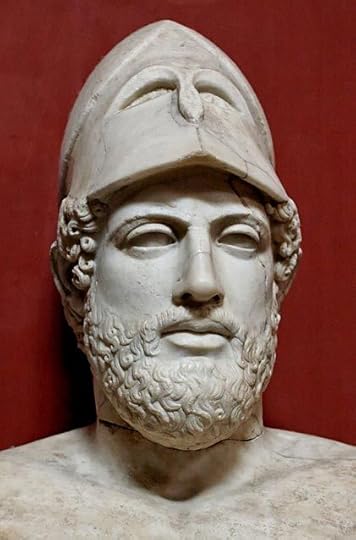 The temple was built under Pericles’s rule. Marble bust of Pericles, Roman copy after a Greek original from ca. 430 BC. (
Public Domain
)The iconic monument is a peripteral octastyle Doric temple with Ionic architectural features, surrounded by a colonnade of eight columns across and seventeen along the length, counting the corner columns twice.
The temple was built under Pericles’s rule. Marble bust of Pericles, Roman copy after a Greek original from ca. 430 BC. (
Public Domain
)The iconic monument is a peripteral octastyle Doric temple with Ionic architectural features, surrounded by a colonnade of eight columns across and seventeen along the length, counting the corner columns twice.
Millions of silver coins may have been stored in Parthenon attic Incredible Construction: Greek Acropolis Built by Ancient Engineers to Resist Earthquakes The Mentor Shipwreck and the Disastrous Journey of the Parthenon Marbles to Britain The main entrance of the temple faces east while the interior length is 100 Attic feet, thus 30.80 meters (101 feet). And though these numbers might seem random to most, the fact is many historians believe great proportions are expressed in these numbers.
 The beautiful ancient Acropolis and Parthenon of Greece. (BigStock image)Messages in MeasurementsAn Attic foot is equivalent to 0.30803 meters, or 1/2F (φ), where F (φ) = 1.61803, also known as the Golden Ratio. The Golden Number F, the number 1.618, is often found in nature, in (human) facial features, in the measurements of the human body, in flowers and other plants, in art, in most living organisms on earth, in shells, in beehives, among many other things, but most important, it’s often associated with the structure of the universe and planetary orbit in our solar system.
The beautiful ancient Acropolis and Parthenon of Greece. (BigStock image)Messages in MeasurementsAn Attic foot is equivalent to 0.30803 meters, or 1/2F (φ), where F (φ) = 1.61803, also known as the Golden Ratio. The Golden Number F, the number 1.618, is often found in nature, in (human) facial features, in the measurements of the human body, in flowers and other plants, in art, in most living organisms on earth, in shells, in beehives, among many other things, but most important, it’s often associated with the structure of the universe and planetary orbit in our solar system.
Furthermore, in aesthetic science the Golden Ratio is considered the most accurate standard for the expression of perfection. So, could all this just be a mere coincidence? Not likely, since inside the Parthenon we find something more impressive—the Fibonacci Sequence, which in mathematics describes the phenomenon of a number being equal to the sum of the previous two: 1, 1, 2, 3, 5, 8, 13, 21, 34, 55, 89, 144, etc. Even more strange, the ratio of the successive pairs tends to the so-called Golden Ratio, or Number F (φ).
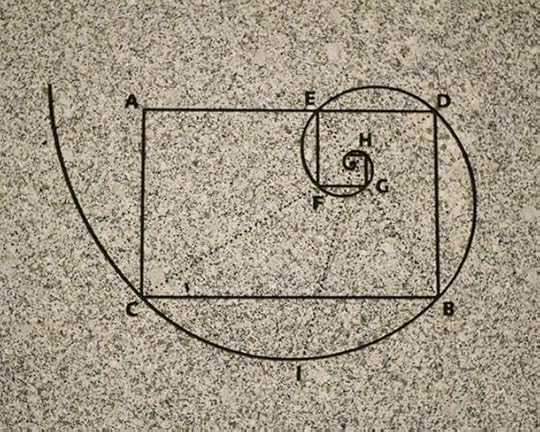 The Golden Ratio (
CC BY-SA 2.0
)Additionally, inside the temple can also be found the number for Pi (π), 3.1416, which appears in the mathematical relation 2F2/10, but more impressively, we meet the number e = 2.72, which is the most important mathematical constant and is the base of the natural logarithm.
The Golden Ratio (
CC BY-SA 2.0
)Additionally, inside the temple can also be found the number for Pi (π), 3.1416, which appears in the mathematical relation 2F2/10, but more impressively, we meet the number e = 2.72, which is the most important mathematical constant and is the base of the natural logarithm.
What makes things more complicated is that the three numbers included in the Parthenon are also included in all of nature and are present in all creation, and nothing can function without them.
Mathematical MysteriesAs one would expect, the questions deriving from the aforementioned facts are many. Did the creators of the Parthenon know these numbers and their importance? And if so, how did they manage to include them in such detail and accuracy in a building which we can’t replicate today even with all our technology and know-how?
How could the ancient Greeks, or more precisely, Ictinus, Callicrates, and Phidias be aware of the Golden Ratio when Midhat J. Gazalé and so many other scholars assure us that it was not until Euclid came along that the Golden Ratio's mathematical properties were studied?
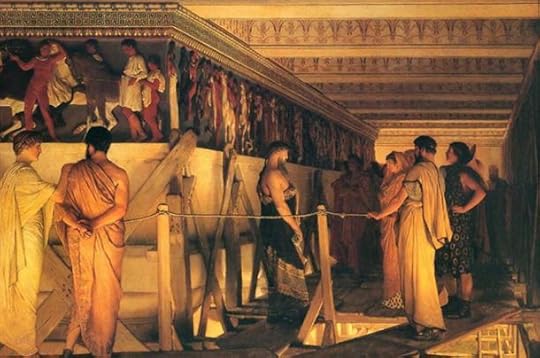 Phidias
Showing the Frieze of the Parthenon to his Friends. (
Public Domain
)How did they know of the Fibonacci Sequence when it was first officially recorded in 1202, almost 1,700 years after the Parthenon was constructed? And most importantly, how could the Parthenon's façade, as well as many of its particular elements, be circumscribed by golden rectangles when the computer technology we take for granted today didn’t exist back then to create such forms?
Phidias
Showing the Frieze of the Parthenon to his Friends. (
Public Domain
)How did they know of the Fibonacci Sequence when it was first officially recorded in 1202, almost 1,700 years after the Parthenon was constructed? And most importantly, how could the Parthenon's façade, as well as many of its particular elements, be circumscribed by golden rectangles when the computer technology we take for granted today didn’t exist back then to create such forms?
Pythagoras and His Life Beyond the Pythagorean Theorem The Golden Ratio – a sacred number that links the past to the present Pankration: A Deadly Martial Art Form from Ancient Greece To all these questions many more can be added as one searches to discover the specific details of the functions and mysteries of the sacred temple; such as, how was the building lighted when there were no windows and, even more oddly, no traces of soot have been found, which excludes the use of torches?
Signals in the SunlightAnother mystery that many experts in various fields have unsuccessfully tried to answer is why, during the day when there is sunlight, do the drop shadows created around the temple always appear to point to other specific destination points in Greece? Which exact points they show and why this happens, or if there’s any special meaning behind this occurrence, has been investigated by scientists for ages, but opinions vary greatly and do not converge with one another, thus preventing us from reaching a solution.
Despite all the scientific, paranormal and mythical mysteries surrounding its legend, the Parthenon remains the cradle of Western civilization—and undoubtedly one of the most significant monuments of humankind as a whole—that continues to attract millions of curious visitors every year. The only sure thing is that we can only learn and benefit from the iconic monument, its unlocked codes and artistic features, which hopefully will be answered in the near future.
Bonus Facts:
The Parthenon is often called sacred because it was dedicated to the goddess Athena, whom the people of Athens considered their patron and guardian of the city.The temple was built under Pericles’s rule, who is considered to be the greatest Athenian statesman ever and the one who gets credited with the birth of democracy as well.The most impressive and glorious part of the Parthenon unfortunately doesn’t exist anymore. It was a gigantic statue of Athena designed and sculpted by Phidias. It was created with elephant ivory and gold and, of course, was dedicated to her.Phidias was also the craftsman who sculpted the statue of Zeus at Olympia, which was one of the Seven Wonders of the ancient world.The Parthenon is considered to be the most copied building in history. Some of the most famous buildings that have been based on it include The New York Stock Exchange, the Reichstag building in Berlin, and the main entrance of the White House.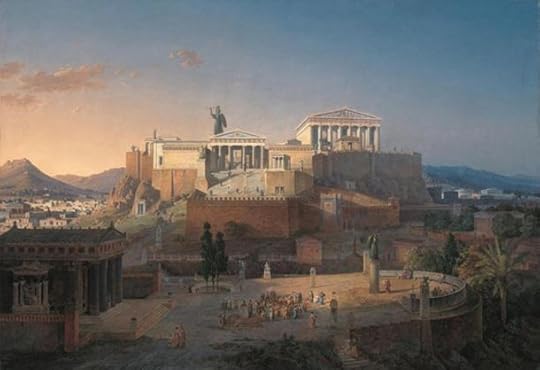 Reconstruction of the Acropolis and Areus Pagus in Athens, Leo von Klenze, 1846. (
Public Domain
)Featured image: The majestic and mysterious Parthenon in Athens, Greece. (BigStock image)
Reconstruction of the Acropolis and Areus Pagus in Athens, Leo von Klenze, 1846. (
Public Domain
)Featured image: The majestic and mysterious Parthenon in Athens, Greece. (BigStock image)
By Theodoros I
 The Parthenon, proudly standing on the Athenian Acropolis, is considered by many historians and archaeologists alike as the undisputed symbol of Athenian democracy and the cradle of Western civilization.
The Parthenon, proudly standing on the Athenian Acropolis, is considered by many historians and archaeologists alike as the undisputed symbol of Athenian democracy and the cradle of Western civilization.The monument is also considered one of the finest buildings of all time by a large number of architects worldwide, attracts millions of tourists each year, and was designed by the most famous sculptor of antiquity, Phidias, while two of the most influential architects ever, Ictinus and Callicrates, supervised the practical construction work of the temple.
The Mysteries of the Ancient TempleContemporary scientists have admitted—despite the Parthenon being the most imitated building in history—that even with modern technology and contemporary architectural techniques, it’s virtually impossible to rebuild the exact same building in all its detail.
 The Acropolis in Athens, Greece, featuring the Parthenon. (BigStock image)But why is the Parthenon so special? What makes it so different from all the others? What kind of details and secrets did the peoples of antiquity know that have been lost to time? Why can’t we construct an identical building to the original Parthenon even though technology, machinery, and architecture have progressed so much since then? There are too many riddles to the construction of the Parthenon, only a few of which can even remotely begin to be unraveled.
The Acropolis in Athens, Greece, featuring the Parthenon. (BigStock image)But why is the Parthenon so special? What makes it so different from all the others? What kind of details and secrets did the peoples of antiquity know that have been lost to time? Why can’t we construct an identical building to the original Parthenon even though technology, machinery, and architecture have progressed so much since then? There are too many riddles to the construction of the Parthenon, only a few of which can even remotely begin to be unraveled.To begin with, the Parthenon might have needed decades to be restored in modern times, but the Athenian citizens mysteriously built it inside of a decade, between 447 and 438 BCE.
 The temple was built under Pericles’s rule. Marble bust of Pericles, Roman copy after a Greek original from ca. 430 BC. (
Public Domain
)The iconic monument is a peripteral octastyle Doric temple with Ionic architectural features, surrounded by a colonnade of eight columns across and seventeen along the length, counting the corner columns twice.
The temple was built under Pericles’s rule. Marble bust of Pericles, Roman copy after a Greek original from ca. 430 BC. (
Public Domain
)The iconic monument is a peripteral octastyle Doric temple with Ionic architectural features, surrounded by a colonnade of eight columns across and seventeen along the length, counting the corner columns twice.Millions of silver coins may have been stored in Parthenon attic Incredible Construction: Greek Acropolis Built by Ancient Engineers to Resist Earthquakes The Mentor Shipwreck and the Disastrous Journey of the Parthenon Marbles to Britain The main entrance of the temple faces east while the interior length is 100 Attic feet, thus 30.80 meters (101 feet). And though these numbers might seem random to most, the fact is many historians believe great proportions are expressed in these numbers.
 The beautiful ancient Acropolis and Parthenon of Greece. (BigStock image)Messages in MeasurementsAn Attic foot is equivalent to 0.30803 meters, or 1/2F (φ), where F (φ) = 1.61803, also known as the Golden Ratio. The Golden Number F, the number 1.618, is often found in nature, in (human) facial features, in the measurements of the human body, in flowers and other plants, in art, in most living organisms on earth, in shells, in beehives, among many other things, but most important, it’s often associated with the structure of the universe and planetary orbit in our solar system.
The beautiful ancient Acropolis and Parthenon of Greece. (BigStock image)Messages in MeasurementsAn Attic foot is equivalent to 0.30803 meters, or 1/2F (φ), where F (φ) = 1.61803, also known as the Golden Ratio. The Golden Number F, the number 1.618, is often found in nature, in (human) facial features, in the measurements of the human body, in flowers and other plants, in art, in most living organisms on earth, in shells, in beehives, among many other things, but most important, it’s often associated with the structure of the universe and planetary orbit in our solar system.Furthermore, in aesthetic science the Golden Ratio is considered the most accurate standard for the expression of perfection. So, could all this just be a mere coincidence? Not likely, since inside the Parthenon we find something more impressive—the Fibonacci Sequence, which in mathematics describes the phenomenon of a number being equal to the sum of the previous two: 1, 1, 2, 3, 5, 8, 13, 21, 34, 55, 89, 144, etc. Even more strange, the ratio of the successive pairs tends to the so-called Golden Ratio, or Number F (φ).
 The Golden Ratio (
CC BY-SA 2.0
)Additionally, inside the temple can also be found the number for Pi (π), 3.1416, which appears in the mathematical relation 2F2/10, but more impressively, we meet the number e = 2.72, which is the most important mathematical constant and is the base of the natural logarithm.
The Golden Ratio (
CC BY-SA 2.0
)Additionally, inside the temple can also be found the number for Pi (π), 3.1416, which appears in the mathematical relation 2F2/10, but more impressively, we meet the number e = 2.72, which is the most important mathematical constant and is the base of the natural logarithm.What makes things more complicated is that the three numbers included in the Parthenon are also included in all of nature and are present in all creation, and nothing can function without them.
Mathematical MysteriesAs one would expect, the questions deriving from the aforementioned facts are many. Did the creators of the Parthenon know these numbers and their importance? And if so, how did they manage to include them in such detail and accuracy in a building which we can’t replicate today even with all our technology and know-how?
How could the ancient Greeks, or more precisely, Ictinus, Callicrates, and Phidias be aware of the Golden Ratio when Midhat J. Gazalé and so many other scholars assure us that it was not until Euclid came along that the Golden Ratio's mathematical properties were studied?
 Phidias
Showing the Frieze of the Parthenon to his Friends. (
Public Domain
)How did they know of the Fibonacci Sequence when it was first officially recorded in 1202, almost 1,700 years after the Parthenon was constructed? And most importantly, how could the Parthenon's façade, as well as many of its particular elements, be circumscribed by golden rectangles when the computer technology we take for granted today didn’t exist back then to create such forms?
Phidias
Showing the Frieze of the Parthenon to his Friends. (
Public Domain
)How did they know of the Fibonacci Sequence when it was first officially recorded in 1202, almost 1,700 years after the Parthenon was constructed? And most importantly, how could the Parthenon's façade, as well as many of its particular elements, be circumscribed by golden rectangles when the computer technology we take for granted today didn’t exist back then to create such forms?Pythagoras and His Life Beyond the Pythagorean Theorem The Golden Ratio – a sacred number that links the past to the present Pankration: A Deadly Martial Art Form from Ancient Greece To all these questions many more can be added as one searches to discover the specific details of the functions and mysteries of the sacred temple; such as, how was the building lighted when there were no windows and, even more oddly, no traces of soot have been found, which excludes the use of torches?
Signals in the SunlightAnother mystery that many experts in various fields have unsuccessfully tried to answer is why, during the day when there is sunlight, do the drop shadows created around the temple always appear to point to other specific destination points in Greece? Which exact points they show and why this happens, or if there’s any special meaning behind this occurrence, has been investigated by scientists for ages, but opinions vary greatly and do not converge with one another, thus preventing us from reaching a solution.
Despite all the scientific, paranormal and mythical mysteries surrounding its legend, the Parthenon remains the cradle of Western civilization—and undoubtedly one of the most significant monuments of humankind as a whole—that continues to attract millions of curious visitors every year. The only sure thing is that we can only learn and benefit from the iconic monument, its unlocked codes and artistic features, which hopefully will be answered in the near future.
Bonus Facts:
The Parthenon is often called sacred because it was dedicated to the goddess Athena, whom the people of Athens considered their patron and guardian of the city.The temple was built under Pericles’s rule, who is considered to be the greatest Athenian statesman ever and the one who gets credited with the birth of democracy as well.The most impressive and glorious part of the Parthenon unfortunately doesn’t exist anymore. It was a gigantic statue of Athena designed and sculpted by Phidias. It was created with elephant ivory and gold and, of course, was dedicated to her.Phidias was also the craftsman who sculpted the statue of Zeus at Olympia, which was one of the Seven Wonders of the ancient world.The Parthenon is considered to be the most copied building in history. Some of the most famous buildings that have been based on it include The New York Stock Exchange, the Reichstag building in Berlin, and the main entrance of the White House.
 Reconstruction of the Acropolis and Areus Pagus in Athens, Leo von Klenze, 1846. (
Public Domain
)Featured image: The majestic and mysterious Parthenon in Athens, Greece. (BigStock image)
Reconstruction of the Acropolis and Areus Pagus in Athens, Leo von Klenze, 1846. (
Public Domain
)Featured image: The majestic and mysterious Parthenon in Athens, Greece. (BigStock image)By Theodoros I
Published on March 14, 2016 03:00
History Trivia - Circus Flaminius built
March 14
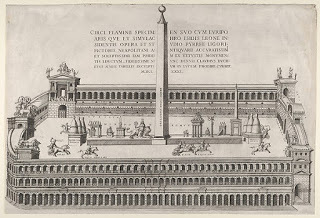
221 BC, the Circus Flaminius was built on the southern side of the Campus Martius, near the Tiber. This large track for chariot racing was named after Gaius Flaminius Nepos, who also constructed the Via Flaminia.
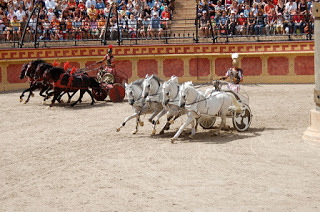

221 BC, the Circus Flaminius was built on the southern side of the Campus Martius, near the Tiber. This large track for chariot racing was named after Gaius Flaminius Nepos, who also constructed the Via Flaminia.

Published on March 14, 2016 02:00
March 13, 2016
Stolen Ring Owned by Joan of Arc Finally Returned to France
Ancient Origins
 Joan of Arc, also known as the Maid of Orleans (or, in French, la Pucelle) was a military hero of the first half of the 15th century. This French saint, whose feast is celebrated on the anniversary of her death, May 30, led the army of Charles VII in the Hundred Years' War to oust the English from France - when she was only 17 years old. Now, after spending nearly six centuries in England, Joan of Arc’s treasured ring returns to France, thanks to the work of the Villiers family, who will exhibit it at the famous Puy de Fou theme park.
Joan of Arc, also known as the Maid of Orleans (or, in French, la Pucelle) was a military hero of the first half of the 15th century. This French saint, whose feast is celebrated on the anniversary of her death, May 30, led the army of Charles VII in the Hundred Years' War to oust the English from France - when she was only 17 years old. Now, after spending nearly six centuries in England, Joan of Arc’s treasured ring returns to France, thanks to the work of the Villiers family, who will exhibit it at the famous Puy de Fou theme park.
.
The ring was stolen by Bishop Cauchon in Rouen when the brave Joan was caught in 1431. When it was taken, Joan shouted at the Bishop “Return it to me!” But the ring was not given back to its owner. Some say that perhaps Joan of Arc confirmed that the ring possessed magical powers.
Cauchon went down in history for having presided over the trial and martyrdom of Joan of Arc, and having been paid by the English. After the robbery, the precious ring was left in the hands of what some people call “Perfidious Albion.”
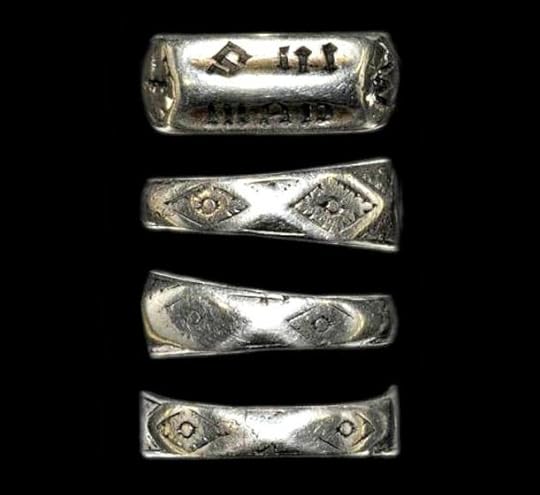 The ring was stolen from Joan of Arc by Bishop Cauchon before the trial which ended with Joan being sentenced to the stake. (
Figaro Magazine/Timeline Auctions
)
The ring was stolen from Joan of Arc by Bishop Cauchon before the trial which ended with Joan being sentenced to the stake. (
Figaro Magazine/Timeline Auctions
)
According to information published in Figaro Magazine, the repatriation of the ring began to take shape on February 24. That day, the lawyer Jacques Trémolet de Villers, who has just published a book about the trial of Joan of Arc, learned that the ring would be auctioned on February 26 in London. After he advised Philippe De Villiers, a politician, businessman, and creator of the Puy du Fou theme park, of the auction, they decided to raise the necessary funds to get the relic back to France. However, the auction house had put a starting price of 19,051 euros (20,984 USD).
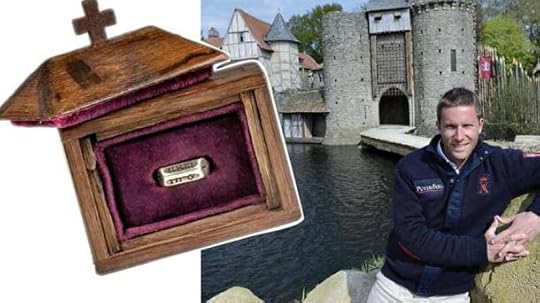 Nicolás de Villiers won the precious ring in a recent auction in London. The ring, accompanied by its own reliquary, cost 376,833 euros. (PhotoPQR/« Ouest-France »/Franck Dubray/Timeline Auctions)Joan of Arc used to wear the ring on the index finger of her left hand. It is forged in brass, decorated with three crosses and is engraved with the initials “JM”. According to legend, Joan had a habit of staring at her ring moments before entering combat.
Nicolás de Villiers won the precious ring in a recent auction in London. The ring, accompanied by its own reliquary, cost 376,833 euros. (PhotoPQR/« Ouest-France »/Franck Dubray/Timeline Auctions)Joan of Arc used to wear the ring on the index finger of her left hand. It is forged in brass, decorated with three crosses and is engraved with the initials “JM”. According to legend, Joan had a habit of staring at her ring moments before entering combat.
The Puy du Fou theme park wrote on its official website that it “aims to contribute to the brilliance of France, its history, its wonders, and its achievements.” It states that it was their “duty to end the exile of this symbol that belonged to the greatest heroine of the history of France.”
Nicolás de Villiers told Figaro Magazine that on March 20 a presentation ceremony will be held for the ring and that the relic will be on display to the public later in a special place in the park.
 "Joan of Arc dies at the stake", painted in 1843 by German artist Hermann Anton Stilke (1803-1860). Hermitage Museum, St. Petersburg. (
Public Domain
) Joan of Arc was eventually condemned to die at the stake, and the ring that her parents had given her for her First Communion spent nearly 600 years in English hands. Featured image: “Joan at the coronation of Charles VII”, painted in 1854 by Jean Auguste Dominique Ingres (1780-1867). Louvre Museum. Source:
Public Domain
"Joan of Arc dies at the stake", painted in 1843 by German artist Hermann Anton Stilke (1803-1860). Hermitage Museum, St. Petersburg. (
Public Domain
) Joan of Arc was eventually condemned to die at the stake, and the ring that her parents had given her for her First Communion spent nearly 600 years in English hands. Featured image: “Joan at the coronation of Charles VII”, painted in 1854 by Jean Auguste Dominique Ingres (1780-1867). Louvre Museum. Source:
Public Domain
By: Mariló T. A.
This article was first published in Spanish at http://www.ancient-origins.es and has been translated with permission.
 Joan of Arc, also known as the Maid of Orleans (or, in French, la Pucelle) was a military hero of the first half of the 15th century. This French saint, whose feast is celebrated on the anniversary of her death, May 30, led the army of Charles VII in the Hundred Years' War to oust the English from France - when she was only 17 years old. Now, after spending nearly six centuries in England, Joan of Arc’s treasured ring returns to France, thanks to the work of the Villiers family, who will exhibit it at the famous Puy de Fou theme park.
Joan of Arc, also known as the Maid of Orleans (or, in French, la Pucelle) was a military hero of the first half of the 15th century. This French saint, whose feast is celebrated on the anniversary of her death, May 30, led the army of Charles VII in the Hundred Years' War to oust the English from France - when she was only 17 years old. Now, after spending nearly six centuries in England, Joan of Arc’s treasured ring returns to France, thanks to the work of the Villiers family, who will exhibit it at the famous Puy de Fou theme park..
The ring was stolen by Bishop Cauchon in Rouen when the brave Joan was caught in 1431. When it was taken, Joan shouted at the Bishop “Return it to me!” But the ring was not given back to its owner. Some say that perhaps Joan of Arc confirmed that the ring possessed magical powers.
Cauchon went down in history for having presided over the trial and martyrdom of Joan of Arc, and having been paid by the English. After the robbery, the precious ring was left in the hands of what some people call “Perfidious Albion.”
 The ring was stolen from Joan of Arc by Bishop Cauchon before the trial which ended with Joan being sentenced to the stake. (
Figaro Magazine/Timeline Auctions
)
The ring was stolen from Joan of Arc by Bishop Cauchon before the trial which ended with Joan being sentenced to the stake. (
Figaro Magazine/Timeline Auctions
)According to information published in Figaro Magazine, the repatriation of the ring began to take shape on February 24. That day, the lawyer Jacques Trémolet de Villers, who has just published a book about the trial of Joan of Arc, learned that the ring would be auctioned on February 26 in London. After he advised Philippe De Villiers, a politician, businessman, and creator of the Puy du Fou theme park, of the auction, they decided to raise the necessary funds to get the relic back to France. However, the auction house had put a starting price of 19,051 euros (20,984 USD).
"We suspected that the sale would beat all records. […] The Puy du Fou Hope Foundation could reach up to €80,000, but not beyond. Then we turned to potential donors and managed to collect the sum of €350,000," explained Nicolas de Villiers to Le Parisien.Speaking of Angels and Saints: The Story of Joan of ArcPope Joan: The Female Pope whose Real Gender was Revealed after she Gave Birth in a ProcessionMarguerite de La Rocque: 16th Century Noblewoman Stranded on the Isle of DemonsThe day of the bid, despite the dizzying auction, Nicolas de Villiers took the ring for a total of 376,833 euros (415,063 USD). The ring was a gift that the parents of the unforgettable Joan had made for her on the day of her First Communion in the church of her hometown, Domremy. Thanks to the Villiers family, it will now return to its home country.
 Nicolás de Villiers won the precious ring in a recent auction in London. The ring, accompanied by its own reliquary, cost 376,833 euros. (PhotoPQR/« Ouest-France »/Franck Dubray/Timeline Auctions)Joan of Arc used to wear the ring on the index finger of her left hand. It is forged in brass, decorated with three crosses and is engraved with the initials “JM”. According to legend, Joan had a habit of staring at her ring moments before entering combat.
Nicolás de Villiers won the precious ring in a recent auction in London. The ring, accompanied by its own reliquary, cost 376,833 euros. (PhotoPQR/« Ouest-France »/Franck Dubray/Timeline Auctions)Joan of Arc used to wear the ring on the index finger of her left hand. It is forged in brass, decorated with three crosses and is engraved with the initials “JM”. According to legend, Joan had a habit of staring at her ring moments before entering combat.The Puy du Fou theme park wrote on its official website that it “aims to contribute to the brilliance of France, its history, its wonders, and its achievements.” It states that it was their “duty to end the exile of this symbol that belonged to the greatest heroine of the history of France.”
Nicolás de Villiers told Figaro Magazine that on March 20 a presentation ceremony will be held for the ring and that the relic will be on display to the public later in a special place in the park.
 "Joan of Arc dies at the stake", painted in 1843 by German artist Hermann Anton Stilke (1803-1860). Hermitage Museum, St. Petersburg. (
Public Domain
) Joan of Arc was eventually condemned to die at the stake, and the ring that her parents had given her for her First Communion spent nearly 600 years in English hands. Featured image: “Joan at the coronation of Charles VII”, painted in 1854 by Jean Auguste Dominique Ingres (1780-1867). Louvre Museum. Source:
Public Domain
"Joan of Arc dies at the stake", painted in 1843 by German artist Hermann Anton Stilke (1803-1860). Hermitage Museum, St. Petersburg. (
Public Domain
) Joan of Arc was eventually condemned to die at the stake, and the ring that her parents had given her for her First Communion spent nearly 600 years in English hands. Featured image: “Joan at the coronation of Charles VII”, painted in 1854 by Jean Auguste Dominique Ingres (1780-1867). Louvre Museum. Source:
Public Domain
By: Mariló T. A.
This article was first published in Spanish at http://www.ancient-origins.es and has been translated with permission.
Published on March 13, 2016 03:30
History Trivia - Felix III becomes Pope
March 13

483 Felix III became pope. He repudiated the Henoticon, a deed of union originating with Patriarch Acacius of Constantinople and published by Emperor Zeno with the view of allaying the strife between the Miaphysite Christians and Chalcedonian Christians. This renunciation initiated the Acacian schism between the Eastern and Western Christian Churches that lasted thirty-five years.

483 Felix III became pope. He repudiated the Henoticon, a deed of union originating with Patriarch Acacius of Constantinople and published by Emperor Zeno with the view of allaying the strife between the Miaphysite Christians and Chalcedonian Christians. This renunciation initiated the Acacian schism between the Eastern and Western Christian Churches that lasted thirty-five years.
Published on March 13, 2016 01:30
March 12, 2016
2500 –Year Old Signet Ring from Tradeswomen Uncovered in Jerusalem
Ancient Origins
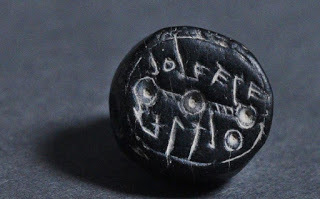
A rare inscription of a woman's name on one semi-precious-stone dating to the First Temple Period has been discovered in Jerusalem.



 The rare seal with the name Elihana bat Gael, along with the name of her father, was recently discovered at a large building during excavations in the City of David in Jerusalem.
The rare seal with the name Elihana bat Gael, along with the name of her father, was recently discovered at a large building during excavations in the City of David in Jerusalem.
The owner of the seal was exceptional compared to other women of the First Temple period, “She had legal status allowing her to conduct business and possess property”, says Israel’s Antiquity Authority.
The discovery is unique and interesting because it turns around the notion transferred into the biblical tradition, that fathers only taught their son´s trade whereas women was thought to be trained to cook and weave. “Finding seals that bear names from the time of the First Temple is hardly a commonplace occurrence, and finding a seal that belonged to a woman is an even rarer phenomenon,” said the Antiquity Authority.
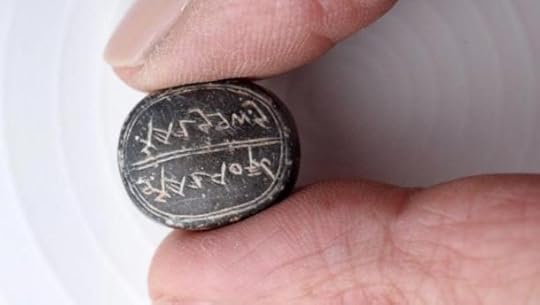 [image error]
[image error]
[image error]
[image error]
[image error]
[image error]
[image error]
[image error]
Recently discovered seal found in the ancient City of David in Jerusalem. Photo Credit: Clara Amit / Israel Antiquities AuthorityMost women’s seals found to this day dating to the first Temple Period bear the names of their fathers, rather than that of their husbands.
The dig yielded another rare seal, belonging to a man named “Sa’aryahu ben Shabenyahu”. The name on the other seal, Sa'aryahu, is not found in the Bible. It has been found on a pottery shard originating from Arad, where the largest collection of ostraca from Biblical times have been found. It includes more than 200 inscribed objects in Hebrew, Aramaic, and other languages. The name “Sa’aryahu is reminiscent to a phrase found in the Book of Job and probably means “the god who is revealed in a storm.”
 The Giv’ati parking lot in Jerusalem where the seals were discovered. The site has been identified as part of the City of David (
public domain
)Royal Judahite AdministrationThe structure discovered with the seals seems to have been an administrative public structure. Among the other discoveries was the capital of a column typical of the period, weights typically used for trading, bulla seals, pottery shards, (inscribed pieces of clay) and fragments of statues of fertility goddesses. “Personal seals, such as those of Elihana and Sa’aryahu, were used for signing documents, and were frequently inlaid as part of a ring that was worn by the owner,” says the head of the excavation, Dr. Doron Ben-Ami of the Hebrew University of Jerusalem and added, “There is a sense that this was an administrative building – indeed, the entire belt surrounding the Temple was apparently not meant for simple buildings,”
The Giv’ati parking lot in Jerusalem where the seals were discovered. The site has been identified as part of the City of David (
public domain
)Royal Judahite AdministrationThe structure discovered with the seals seems to have been an administrative public structure. Among the other discoveries was the capital of a column typical of the period, weights typically used for trading, bulla seals, pottery shards, (inscribed pieces of clay) and fragments of statues of fertility goddesses. “Personal seals, such as those of Elihana and Sa’aryahu, were used for signing documents, and were frequently inlaid as part of a ring that was worn by the owner,” says the head of the excavation, Dr. Doron Ben-Ami of the Hebrew University of Jerusalem and added, “There is a sense that this was an administrative building – indeed, the entire belt surrounding the Temple was apparently not meant for simple buildings,”
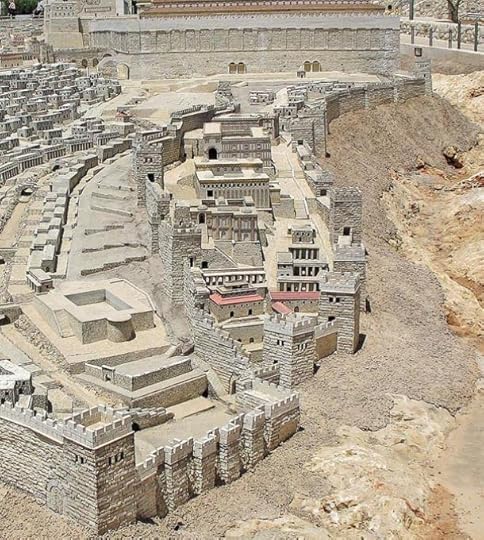 [image error]
[image error]
[image error]
[image error]
[image error]
[image error]
[image error]
[image error]
A digital reconstruction of the Biblical City of David in the period of Herod's Temple. The southern wall of the Temple Mount appears at top. ( public domain )The signet ring of a ruler or official was a symbol of his authority. “In antiquity, they designated the identity, genealogy and status of the owner of the seal,” said the excavators. Official documents or things not to be tampered with or altered were sealed with them, similar to the manner in which official seals or signatures are used in modern time.
The excavations in one of the largest archaeological digs in the history of Jerusalem in the City of David have been going on for nine years now and have yielded hundreds of interesting finds, among them the Hezekiah seal discovered last year that proves Jerusalem was a major Judahite capital during the 8th century BCE. As excavations are carried out in the Giv’ati parking lot at the City of David, new finds will surface that will change our understanding of the history eternal city of Jerusalem.
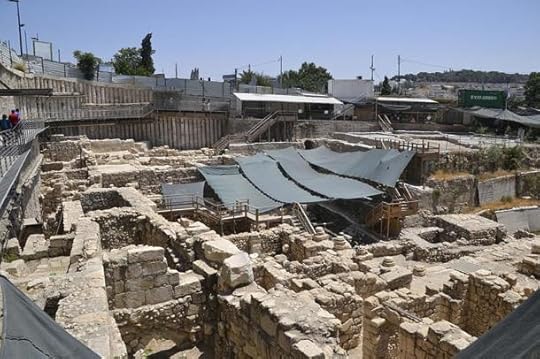 Excavation work being carried out in the City of David (
public domain
)Featured image: Recently discovered seal found in the ancient City of David in Jerusalem. Photo Credit: Clara Amit / Israel Antiquities Authority
Excavation work being carried out in the City of David (
public domain
)Featured image: Recently discovered seal found in the ancient City of David in Jerusalem. Photo Credit: Clara Amit / Israel Antiquities Authority
By Sam Bostrom

A rare inscription of a woman's name on one semi-precious-stone dating to the First Temple Period has been discovered in Jerusalem.



 The rare seal with the name Elihana bat Gael, along with the name of her father, was recently discovered at a large building during excavations in the City of David in Jerusalem.
The rare seal with the name Elihana bat Gael, along with the name of her father, was recently discovered at a large building during excavations in the City of David in Jerusalem.The owner of the seal was exceptional compared to other women of the First Temple period, “She had legal status allowing her to conduct business and possess property”, says Israel’s Antiquity Authority.
The discovery is unique and interesting because it turns around the notion transferred into the biblical tradition, that fathers only taught their son´s trade whereas women was thought to be trained to cook and weave. “Finding seals that bear names from the time of the First Temple is hardly a commonplace occurrence, and finding a seal that belonged to a woman is an even rarer phenomenon,” said the Antiquity Authority.
 [image error]
[image error]
[image error]
[image error]
[image error]
[image error]
[image error]
[image error]Recently discovered seal found in the ancient City of David in Jerusalem. Photo Credit: Clara Amit / Israel Antiquities AuthorityMost women’s seals found to this day dating to the first Temple Period bear the names of their fathers, rather than that of their husbands.
“It seems that Elihana maintained her right to property and financial independence, even after her marriage, and therefore her father’s name was retained. However, we do not have sufficient information about the law in Judah during this period.” Said Dr. Hagai Misgav of Hebrew University in Jerusalem and added:Although the name Elihana does not occur in the Bible, an Ammonite seal with a similar name, Eliya, has been found dating to the same period. Eliya is the female form of the biblical name “Eli”. Interestingly the biblical book of Nehemiah speaks of traders and the sellers of all kinds of merchandise who went to Jerusalem.
“Here, as in other cases, this might indicate the relatively elevated status of Elihana, which depended on her original family, and not on her husband’s family,”
The dig yielded another rare seal, belonging to a man named “Sa’aryahu ben Shabenyahu”. The name on the other seal, Sa'aryahu, is not found in the Bible. It has been found on a pottery shard originating from Arad, where the largest collection of ostraca from Biblical times have been found. It includes more than 200 inscribed objects in Hebrew, Aramaic, and other languages. The name “Sa’aryahu is reminiscent to a phrase found in the Book of Job and probably means “the god who is revealed in a storm.”
 The Giv’ati parking lot in Jerusalem where the seals were discovered. The site has been identified as part of the City of David (
public domain
)Royal Judahite AdministrationThe structure discovered with the seals seems to have been an administrative public structure. Among the other discoveries was the capital of a column typical of the period, weights typically used for trading, bulla seals, pottery shards, (inscribed pieces of clay) and fragments of statues of fertility goddesses. “Personal seals, such as those of Elihana and Sa’aryahu, were used for signing documents, and were frequently inlaid as part of a ring that was worn by the owner,” says the head of the excavation, Dr. Doron Ben-Ami of the Hebrew University of Jerusalem and added, “There is a sense that this was an administrative building – indeed, the entire belt surrounding the Temple was apparently not meant for simple buildings,”
The Giv’ati parking lot in Jerusalem where the seals were discovered. The site has been identified as part of the City of David (
public domain
)Royal Judahite AdministrationThe structure discovered with the seals seems to have been an administrative public structure. Among the other discoveries was the capital of a column typical of the period, weights typically used for trading, bulla seals, pottery shards, (inscribed pieces of clay) and fragments of statues of fertility goddesses. “Personal seals, such as those of Elihana and Sa’aryahu, were used for signing documents, and were frequently inlaid as part of a ring that was worn by the owner,” says the head of the excavation, Dr. Doron Ben-Ami of the Hebrew University of Jerusalem and added, “There is a sense that this was an administrative building – indeed, the entire belt surrounding the Temple was apparently not meant for simple buildings,” [image error]
[image error]
[image error]
[image error]
[image error]
[image error]
[image error]
[image error]A digital reconstruction of the Biblical City of David in the period of Herod's Temple. The southern wall of the Temple Mount appears at top. ( public domain )The signet ring of a ruler or official was a symbol of his authority. “In antiquity, they designated the identity, genealogy and status of the owner of the seal,” said the excavators. Official documents or things not to be tampered with or altered were sealed with them, similar to the manner in which official seals or signatures are used in modern time.
The excavations in one of the largest archaeological digs in the history of Jerusalem in the City of David have been going on for nine years now and have yielded hundreds of interesting finds, among them the Hezekiah seal discovered last year that proves Jerusalem was a major Judahite capital during the 8th century BCE. As excavations are carried out in the Giv’ati parking lot at the City of David, new finds will surface that will change our understanding of the history eternal city of Jerusalem.
 Excavation work being carried out in the City of David (
public domain
)Featured image: Recently discovered seal found in the ancient City of David in Jerusalem. Photo Credit: Clara Amit / Israel Antiquities Authority
Excavation work being carried out in the City of David (
public domain
)Featured image: Recently discovered seal found in the ancient City of David in Jerusalem. Photo Credit: Clara Amit / Israel Antiquities AuthorityBy Sam Bostrom
Published on March 12, 2016 03:00
History Trivia - Cesare Borgia killed in battle
March 12

1507 Cesare Borgia was killed while fighting for the Navarrese king in the city of Viana, Spain.

1507 Cesare Borgia was killed while fighting for the Navarrese king in the city of Viana, Spain.
Published on March 12, 2016 02:00
March 11, 2016
Mysterious Underground Labyrinth in Scotland May Have Originally Been a Druid Temple
Ancient Origins
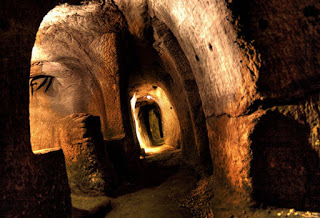 The latest research at Gilmerton Cove suggests that the mysterious network of underground tunnels was once a Druid temple that dates back more than 2000 years. For centuries, the hand-carved passageways and hidden chambers have been linked to smugglers, the Knights Templar, and witchcraft.
The latest research at Gilmerton Cove suggests that the mysterious network of underground tunnels was once a Druid temple that dates back more than 2000 years. For centuries, the hand-carved passageways and hidden chambers have been linked to smugglers, the Knights Templar, and witchcraft.


 Gilmerton Cove is located in Gilmerton, a suburb of Edinburgh, Scotland. In 2003, it was opened for visitors, and ever since then it has been an educational and fun attraction. At the same time, the site’s still an object of restoration and conservation work, preserving it for future generations. Most experts who research this site have been unable to pinpoint the true origins behind several stone tables and chairs found within Gilmerton Cove.
Gilmerton Cove is located in Gilmerton, a suburb of Edinburgh, Scotland. In 2003, it was opened for visitors, and ever since then it has been an educational and fun attraction. At the same time, the site’s still an object of restoration and conservation work, preserving it for future generations. Most experts who research this site have been unable to pinpoint the true origins behind several stone tables and chairs found within Gilmerton Cove.
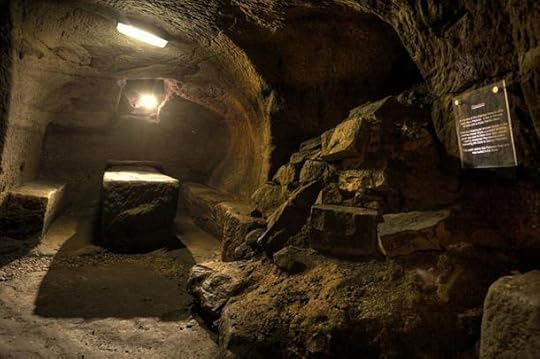 Inside Gilmerton Cove. (CC BY SA 2.0)According to Julian Spalding, a writer, art expert, historian, and the former head of Glasgow's museums and galleries, the temple could have been in use for centuries. He believes that further work at Gilmerton Cove may unlock many of the secrets connected with the mysterious labyrinth.
Inside Gilmerton Cove. (CC BY SA 2.0)According to Julian Spalding, a writer, art expert, historian, and the former head of Glasgow's museums and galleries, the temple could have been in use for centuries. He believes that further work at Gilmerton Cove may unlock many of the secrets connected with the mysterious labyrinth.
The official records state that this place was created by local blacksmith George Paterson in 1724. Until now, nobody had proof for anything different. However, now Spalding may found the right way to explain the origins of the site. He claims that a temple was deliberately buried by the ancient Druids to protect the sacred nature of the place. He is convinced that Paterson simply dug out rubble used to fill in the remains of the temple. As Spalding told the Scotsman newspaper:
Medieval mass grave lay hidden just two feet below a college in ScotlandArchaeologists in Scotland investigate the mystery of the Rhynie ManWoe of the Witches – The Elevated Flying Rowan TreeThoth’s Storm: New Evidence for Ancient Egyptians in Ireland?Many of the members were also important figures of Parliament, Lords, etc. But in the opinion of Julian Spalding, the Hellfire Club was interested in the site because of the much older fame of the location.
 [image error]
[image error]<a href="http://us-ads.openx.net/w/1.0/rc?cs=1..." ><img src="http://us-ads.openx.net/w/1.0/ai?auid..." border="0" alt=""></a>
[image error]
[image error]<a href="http://us-ads.openx.net/w/1.0/rc?cs=1..." ><img src="http://us-ads.openx.net/w/1.0/ai?auid..." border="0" alt=""></a>
Portrait of Sir Francis Dashwood, 11th Baron le Despencer, by William Hogarth. (Public Domain)Spalding believes that the shapes of the rooms and passages is related to the womb, and were carved during Celtic times, or from an even earlier culture. He claims that the identification of Gilmerton Cove as a Druid temple makes sense with all the evidence. According to his research, the site is dated back to the Iron Age and it contains lots of proof for its origins because of its good condition. Spalding summarized:
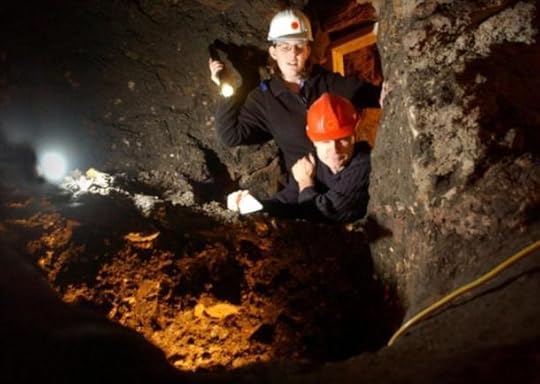 Archaeologists Sam Badger and Magnus Kirby investigate the mysterious tunnels. (Pamela Grigg)Historical sites connected with Druids are also in other parts of the UK. According to the Independent, at the village of Stanway, Essex, near Colchester, the grave of an Iron Age man was found in 1996. The remains are known as the ‘Druid of Colchester’ and were dated to about 40-60 AD. He could have been a Druid, a medical doctor, or both.
Archaeologists Sam Badger and Magnus Kirby investigate the mysterious tunnels. (Pamela Grigg)Historical sites connected with Druids are also in other parts of the UK. According to the Independent, at the village of Stanway, Essex, near Colchester, the grave of an Iron Age man was found in 1996. The remains are known as the ‘Druid of Colchester’ and were dated to about 40-60 AD. He could have been a Druid, a medical doctor, or both.
The bones were discovered among a number of graves of important people from this period. The wooden chambered burial site included not only human remains, but also a board game, a decorated cloak, a jet bead (which is believed to have magical properties), and medical equipment. The medical kit consisted of 13 instruments, such as scalpels, needles, surgical saw, hooks, sharp and blunt retractors, etc.
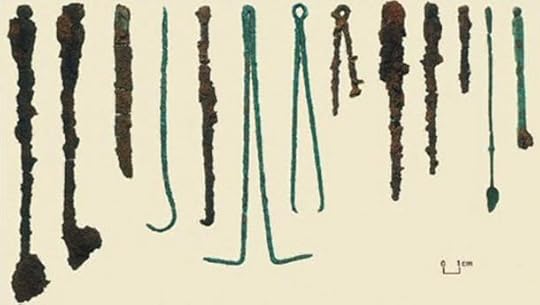 [image error]
[image error]<a href="http://us-ads.openx.net/w/1.0/rc?cs=1..." ><img src="http://us-ads.openx.net/w/1.0/ai?auid..." border="0" alt=""></a>
[image error]
[image error]<a href="http://us-ads.openx.net/w/1.0/rc?cs=1..." ><img src="http://us-ads.openx.net/w/1.0/ai?auid..." border="0" alt=""></a>
Surgical Tools found with the ‘Druid of Colchester.’ (Public Domain)Featured Image: A tunnel in Gilmerton Cove. Source: John Dale/CC BY SA 2.0
By Natalia Klimczak
 The latest research at Gilmerton Cove suggests that the mysterious network of underground tunnels was once a Druid temple that dates back more than 2000 years. For centuries, the hand-carved passageways and hidden chambers have been linked to smugglers, the Knights Templar, and witchcraft.
The latest research at Gilmerton Cove suggests that the mysterious network of underground tunnels was once a Druid temple that dates back more than 2000 years. For centuries, the hand-carved passageways and hidden chambers have been linked to smugglers, the Knights Templar, and witchcraft.

 Gilmerton Cove is located in Gilmerton, a suburb of Edinburgh, Scotland. In 2003, it was opened for visitors, and ever since then it has been an educational and fun attraction. At the same time, the site’s still an object of restoration and conservation work, preserving it for future generations. Most experts who research this site have been unable to pinpoint the true origins behind several stone tables and chairs found within Gilmerton Cove.
Gilmerton Cove is located in Gilmerton, a suburb of Edinburgh, Scotland. In 2003, it was opened for visitors, and ever since then it has been an educational and fun attraction. At the same time, the site’s still an object of restoration and conservation work, preserving it for future generations. Most experts who research this site have been unable to pinpoint the true origins behind several stone tables and chairs found within Gilmerton Cove. Inside Gilmerton Cove. (CC BY SA 2.0)According to Julian Spalding, a writer, art expert, historian, and the former head of Glasgow's museums and galleries, the temple could have been in use for centuries. He believes that further work at Gilmerton Cove may unlock many of the secrets connected with the mysterious labyrinth.
Inside Gilmerton Cove. (CC BY SA 2.0)According to Julian Spalding, a writer, art expert, historian, and the former head of Glasgow's museums and galleries, the temple could have been in use for centuries. He believes that further work at Gilmerton Cove may unlock many of the secrets connected with the mysterious labyrinth.The official records state that this place was created by local blacksmith George Paterson in 1724. Until now, nobody had proof for anything different. However, now Spalding may found the right way to explain the origins of the site. He claims that a temple was deliberately buried by the ancient Druids to protect the sacred nature of the place. He is convinced that Paterson simply dug out rubble used to fill in the remains of the temple. As Spalding told the Scotsman newspaper:
“It is very probable that the whole complex was deliberately buried, a widespread ancient practice which prevented the subsequent defilement of sacred sites. This interpretation explains why two passages are still blocked by unexcavated rubble. It is inexplicable why Paterson should have filled them up after going to the immense trouble of excavating them. The work is beautifully consistent throughout and indicates a team of highly-skilled craftsmen, with numerous assistants, guided by a mastermind.”The connection with witchcraft in the Gilmerton Cove is usually linked with the use of the site by the 18th century “Hellfire Club.” This group was formed in the 1740s by Sir Francis Dashwood, owner of West Wycombe, Buckinghamshire. The main goal for this gentleman’s club was a hedonistic lifestyle connected with spending time with women, drinking wine, and enjoying music. Some researchers note that there were religious practices connected with the sexual activity of the group.
Medieval mass grave lay hidden just two feet below a college in ScotlandArchaeologists in Scotland investigate the mystery of the Rhynie ManWoe of the Witches – The Elevated Flying Rowan TreeThoth’s Storm: New Evidence for Ancient Egyptians in Ireland?Many of the members were also important figures of Parliament, Lords, etc. But in the opinion of Julian Spalding, the Hellfire Club was interested in the site because of the much older fame of the location.
 [image error]
[image error]<a href="http://us-ads.openx.net/w/1.0/rc?cs=1..." ><img src="http://us-ads.openx.net/w/1.0/ai?auid..." border="0" alt=""></a>
[image error]
[image error]<a href="http://us-ads.openx.net/w/1.0/rc?cs=1..." ><img src="http://us-ads.openx.net/w/1.0/ai?auid..." border="0" alt=""></a>Portrait of Sir Francis Dashwood, 11th Baron le Despencer, by William Hogarth. (Public Domain)Spalding believes that the shapes of the rooms and passages is related to the womb, and were carved during Celtic times, or from an even earlier culture. He claims that the identification of Gilmerton Cove as a Druid temple makes sense with all the evidence. According to his research, the site is dated back to the Iron Age and it contains lots of proof for its origins because of its good condition. Spalding summarized:
“Druids were known to meet in secret in woods and caves away from habitation. Gilmerton is on a high ridge, marked with megaliths, overlooking Cramond, the site of mankind’s earliest settlement in Scotland, and, later, a Roman Fort. If it is a Druid temple, discovered by chance in the 18th Century, then it will be the first substantial archaeological evidence of this sophisticated and highly-secretive priesthood.”Nowadays, the entrance to Gilmerton Cove is through what looks like a traditional mining cottage. Julian Spalding hopes that it will receive a world heritage status. If the future works in Gilmerton Cove confirm Spalding’s hypothesis, it will be another place on the Druid path, joining locations like Rosslyn near Edinburgh, Cairnpapple cairn near Bathgate, Dingwall (the ancient Viking capital of Scotland), Callanish (the land of the goddess Brigit), and many others.
 Archaeologists Sam Badger and Magnus Kirby investigate the mysterious tunnels. (Pamela Grigg)Historical sites connected with Druids are also in other parts of the UK. According to the Independent, at the village of Stanway, Essex, near Colchester, the grave of an Iron Age man was found in 1996. The remains are known as the ‘Druid of Colchester’ and were dated to about 40-60 AD. He could have been a Druid, a medical doctor, or both.
Archaeologists Sam Badger and Magnus Kirby investigate the mysterious tunnels. (Pamela Grigg)Historical sites connected with Druids are also in other parts of the UK. According to the Independent, at the village of Stanway, Essex, near Colchester, the grave of an Iron Age man was found in 1996. The remains are known as the ‘Druid of Colchester’ and were dated to about 40-60 AD. He could have been a Druid, a medical doctor, or both.The bones were discovered among a number of graves of important people from this period. The wooden chambered burial site included not only human remains, but also a board game, a decorated cloak, a jet bead (which is believed to have magical properties), and medical equipment. The medical kit consisted of 13 instruments, such as scalpels, needles, surgical saw, hooks, sharp and blunt retractors, etc.
 [image error]
[image error]<a href="http://us-ads.openx.net/w/1.0/rc?cs=1..." ><img src="http://us-ads.openx.net/w/1.0/ai?auid..." border="0" alt=""></a>
[image error]
[image error]<a href="http://us-ads.openx.net/w/1.0/rc?cs=1..." ><img src="http://us-ads.openx.net/w/1.0/ai?auid..." border="0" alt=""></a>Surgical Tools found with the ‘Druid of Colchester.’ (Public Domain)Featured Image: A tunnel in Gilmerton Cove. Source: John Dale/CC BY SA 2.0
By Natalia Klimczak
Published on March 11, 2016 03:30
History Trivia - Mount Etna (Sicily) erupts
March 11

1669 Mount Etna (Sicily) erupted. 990,000,000 cubic yards of lava were thrown out over four months, destroying a dozen villages. Ashes formed a double cone more than 150 ft high, now called Monti Rossi.

1669 Mount Etna (Sicily) erupted. 990,000,000 cubic yards of lava were thrown out over four months, destroying a dozen villages. Ashes formed a double cone more than 150 ft high, now called Monti Rossi.
Published on March 11, 2016 02:00
March 10, 2016
Britain’s 7 most amazing ruins
History Extra
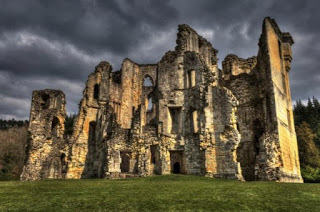
Old Wardour Castle (photo by Derek Finch)
In Wild Ruins, the first ever guidebook to Britain’s ruins, writer Dave Hamilton details how to visit and gain access to more than 250 hidden historical spots. Featuring a vast number of images and 28 maps, the book reveals the whereabouts of long-forgotten castles, mills, cottages, quays, airfields, Victorian forts and intriguing derelicts.
Here, writing for History Extra, Hamilton shares seven of his favourite ruins, and explains their historical significance.
If history is written by the victors, as Winston Churchill allegedly said, then what of the losers; how is their tale told? Our nation’s ruins offer this alternative history. Ruins tell the story of a constantly shifting balance of power. They tell us how even mighty armies and steadfast institutions can topple in the shifting sands of time. Ruins tell us of the forces, often way beyond our control, that continue to shape our lives to this day. The history of the ruin is, after all, the history written by the losing side.
1) Skara Brae – Mainland, OrkneyOne February night in 1850, a storm raged its way through Scotland and up to the Orkney Islands. It was so ferocious that many were killed, and in Mainland Orkney a large layer of sand and turf was ripped from the coastline.
The next morning, locals found a number of roofless circular dwellings where once stood a large irregular dune. This was to be one of the most significant finds of the period. At first it was thought to be a Pictish settlement dating back to the Iron Age, around 500 BC. Much later, radiocarbon dating proved this estimate to be out by at least 2,000 years. Although estimates vary, it is thought the settlement was inhabited somewhere between 3,200 and 2,200 BC.
Being under the cover of sand for so long has meant that the village at Skara Brae is perhaps the best-preserved collection of Neolithic buildings in Europe. Built-in stone furniture still survives, and such is the level of detail it is easy to make out where inhabitants had their beds, where they lit their fires, and where they stored their food.
Skara Brae, situated 19 miles north-west of the port of Kirkwall, Orkney, is today managed by Historic Scotland.
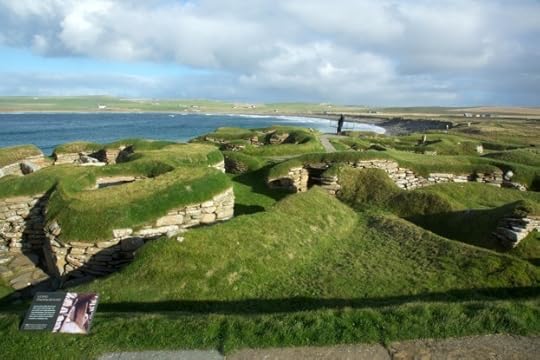 Skara Brae (Photo by Derreck Prescott)
Skara Brae (Photo by Derreck Prescott)
2) St Helen’s Oratory and Cape Cornwall Tin Mine, CornwallUntil the Ordnance Survey mapped the area, Cape Cornwall was thought to be the most westerly point in Britain. Situated four miles from Land’s End, just off the South West Coast Path, it is a beautiful and wild place, where on a sunny day the blueness of the sky is surpassed only by the vast expanse of Cornish sea.
As the only cape in England, it marks the meeting place of the swirling tides of both the Atlantic Ocean and the English Channel. The Cape is also a place where different tides of history meet. The ruined St Helen’s Oratory is an exquisite little ruin with grass and ferns growing from its crumbling walls, thought to date back to Romano-British times.
Much later, Cape Cornwall was home to a thriving tin mine big enough to need a large engine-house. Nearly all signs of the mine have vanished, and now all that remains is a single chimneystack at the end of a bracing walk at the peak of the Cape.
Cape Cornwall is today owned by the National Trust.
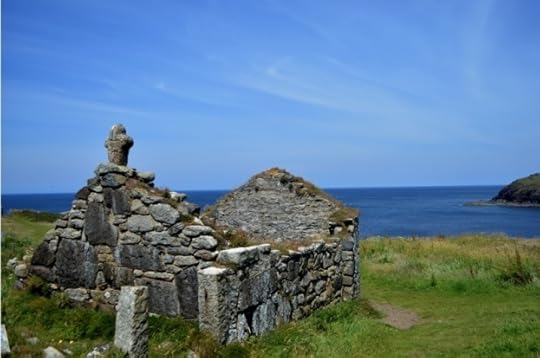
St Helen’s Oratory (Photo by Dave Hamilton)
3) Old Wardour Castle, WiltshireOne of the most striking yet often overlooked ruins in the country is that of 14th-century Old Wardour Castle. Serving as a testament to its splendour, Capability Brown used it as a landscape feature when he designed the gardens of the New Wardour House toward the end of the 18th century. But in 1643, the castle was put to the test as a stronghold when 1,300 parliamentary troops laid siege.
With her husband away, 61-year-old Lady Blanche Arundell was left to defend the castle with just 25 retained staff, including cooks and gardeners. Despite being massively outnumbered, the valiant Lady Arundell held out for five days before she eventually surrendered. The castle didn’t stay in the hands of the invading force for long: the following year Lady Arundell’s son, Henry Arundell, 3rd Baron Arundell of Wardour, returned to win back the family castle. During the siege, however, he blew up a substantial part of the castle and it was damaged beyond repair.
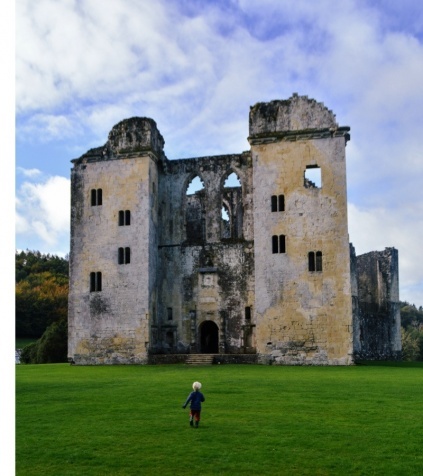
Old Wardour Castle (Photo by Dave Hamilton)
4) Bromholm Priory, NorfolkMuch lesser-known than the East Anglian ruins of Thetford and Dunwich Priory, Bromholm Priory is still a magnificent ruin in its own right, standing abandoned among fields of corn not far from the Norfolk coast. Founded in 1113, this Cluniac priory was built as a subordinate house of Castle Acre.
During the following century it became one of the most religiously significant buildings in Norfolk, if not the country, largely due to the dubious claim that is contained part of the ‘true’ cross. The priory quickly became a pilgrimage route and is immortalised in Chaucer’s The Reeve’s Tale. Sadly, it has remained a ruin since the dissolution of the monasteries.
During the Second World War, the building briefly came back to life as a defensive structure rather than a building of worship. Somewhat unceremoniously, the basement of the building was modified to house a concrete pillbox in case of an enemy invasion. Thankfully, the pillbox is barely visible and it is possible (although perhaps not advisable!) to crawl into this underground chamber from a gap at ground level.
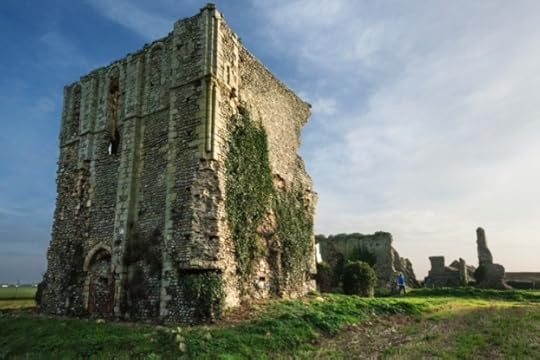
Bromholm Priory (Photo by Steve Cabellero)
5) Ardvreck Castle, Scottish HighlandsJutting out into Loch Assynt, and surrounded by the Quinag peaks and the Inchnadamph forest, Ardvreck Castle is among the most breathtaking ruins in Scotland.
Ardvreck is a clan castle, built by the MacLeods of Assynt in the late 16th century. The story goes that a famous betrayal took place here: in 1650, the Royalist James Graham, 1st Marquess of Montrose, was tricked into its dungeon and later sent to Edinburgh to be executed. If you believe in such things, his ghost is said to haunt the castle to this day.
A short drive – or a challenging but reasonable walk – from the ruins is the famous Bone Cave of Inchnadamph. Here the bones of reindeers, brown bears, arctic foxes, lynxes and polar bears were found, dating back over the past 45,000 years.

Ardvreck Castle (Photo by Dave Hamilton)
6) Anglesey Barracks, North WalesDespite its name, Anglesey Barracks are not on the Isle of Anglesey, and it has never been linked to the military or housed any military personnel. Instead, these twin rows of abandoned houses were home to quarrymen working at the nearby Dinorwic Quarry. The workers would have left their homes on Anglesey to lodge in the cottages, which consisted of just a bedroom and living room. These were far from luxurious dwellings, with no running water or electricity, and each cottage would have had to house four men within their cramped four walls.
Dramatically perched on a Welsh hillside, the houses overlook the romantic ruin of Dolbardarn Castle and the large expanse of water, Llyn Peris.
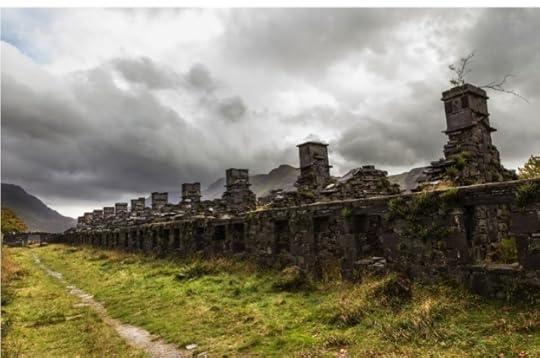
Anglesey Barracks (Photo by Dave Hamilton)
7) Abbot's Cliff Sound Mirrors, KentDuring the First World War and interwar period, and before the invention of radar, a rather unusual detection device was devised to warn of incoming enemy planes, the ruins of which remain with us today.
Sets of large, concrete parabolic discs known as ‘sound mirrors’ were installed on the English coast, mainly in Kent and the North of England, and staffed by personnel with stethoscopes who would quite literally listen to what was flying in.
As planes became faster, however, these sound mirrors became obsolete, since once a plane was detected it was already over the head of the listener. Standing above the white cliffs between Dover and Folkestone, the Abbot’s Cliff Sound Mirror is one of the most accessible examples of this eccentric and short-lived British technology.
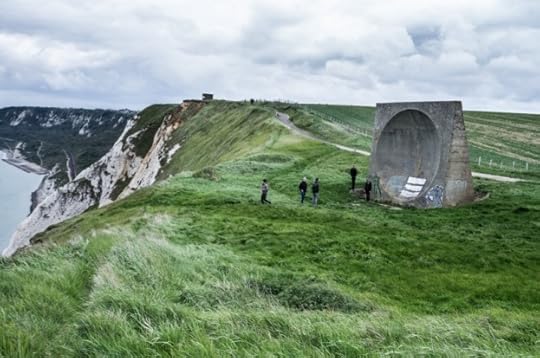
Abbot's Cliff Sound Mirrors (Photo by Sam Velghe)
Wild Ruins: The Explorer's Guide to Britain's Lost Castles, Follies, Relics and Remains by Dave Hamilton (WildThingsPublishing.com, £16.99) is available now. To find out more, click here.

Old Wardour Castle (photo by Derek Finch)
In Wild Ruins, the first ever guidebook to Britain’s ruins, writer Dave Hamilton details how to visit and gain access to more than 250 hidden historical spots. Featuring a vast number of images and 28 maps, the book reveals the whereabouts of long-forgotten castles, mills, cottages, quays, airfields, Victorian forts and intriguing derelicts.
Here, writing for History Extra, Hamilton shares seven of his favourite ruins, and explains their historical significance.
If history is written by the victors, as Winston Churchill allegedly said, then what of the losers; how is their tale told? Our nation’s ruins offer this alternative history. Ruins tell the story of a constantly shifting balance of power. They tell us how even mighty armies and steadfast institutions can topple in the shifting sands of time. Ruins tell us of the forces, often way beyond our control, that continue to shape our lives to this day. The history of the ruin is, after all, the history written by the losing side.
1) Skara Brae – Mainland, OrkneyOne February night in 1850, a storm raged its way through Scotland and up to the Orkney Islands. It was so ferocious that many were killed, and in Mainland Orkney a large layer of sand and turf was ripped from the coastline.
The next morning, locals found a number of roofless circular dwellings where once stood a large irregular dune. This was to be one of the most significant finds of the period. At first it was thought to be a Pictish settlement dating back to the Iron Age, around 500 BC. Much later, radiocarbon dating proved this estimate to be out by at least 2,000 years. Although estimates vary, it is thought the settlement was inhabited somewhere between 3,200 and 2,200 BC.
Being under the cover of sand for so long has meant that the village at Skara Brae is perhaps the best-preserved collection of Neolithic buildings in Europe. Built-in stone furniture still survives, and such is the level of detail it is easy to make out where inhabitants had their beds, where they lit their fires, and where they stored their food.
Skara Brae, situated 19 miles north-west of the port of Kirkwall, Orkney, is today managed by Historic Scotland.
 Skara Brae (Photo by Derreck Prescott)
Skara Brae (Photo by Derreck Prescott)2) St Helen’s Oratory and Cape Cornwall Tin Mine, CornwallUntil the Ordnance Survey mapped the area, Cape Cornwall was thought to be the most westerly point in Britain. Situated four miles from Land’s End, just off the South West Coast Path, it is a beautiful and wild place, where on a sunny day the blueness of the sky is surpassed only by the vast expanse of Cornish sea.
As the only cape in England, it marks the meeting place of the swirling tides of both the Atlantic Ocean and the English Channel. The Cape is also a place where different tides of history meet. The ruined St Helen’s Oratory is an exquisite little ruin with grass and ferns growing from its crumbling walls, thought to date back to Romano-British times.
Much later, Cape Cornwall was home to a thriving tin mine big enough to need a large engine-house. Nearly all signs of the mine have vanished, and now all that remains is a single chimneystack at the end of a bracing walk at the peak of the Cape.
Cape Cornwall is today owned by the National Trust.

St Helen’s Oratory (Photo by Dave Hamilton)
3) Old Wardour Castle, WiltshireOne of the most striking yet often overlooked ruins in the country is that of 14th-century Old Wardour Castle. Serving as a testament to its splendour, Capability Brown used it as a landscape feature when he designed the gardens of the New Wardour House toward the end of the 18th century. But in 1643, the castle was put to the test as a stronghold when 1,300 parliamentary troops laid siege.
With her husband away, 61-year-old Lady Blanche Arundell was left to defend the castle with just 25 retained staff, including cooks and gardeners. Despite being massively outnumbered, the valiant Lady Arundell held out for five days before she eventually surrendered. The castle didn’t stay in the hands of the invading force for long: the following year Lady Arundell’s son, Henry Arundell, 3rd Baron Arundell of Wardour, returned to win back the family castle. During the siege, however, he blew up a substantial part of the castle and it was damaged beyond repair.

Old Wardour Castle (Photo by Dave Hamilton)
4) Bromholm Priory, NorfolkMuch lesser-known than the East Anglian ruins of Thetford and Dunwich Priory, Bromholm Priory is still a magnificent ruin in its own right, standing abandoned among fields of corn not far from the Norfolk coast. Founded in 1113, this Cluniac priory was built as a subordinate house of Castle Acre.
During the following century it became one of the most religiously significant buildings in Norfolk, if not the country, largely due to the dubious claim that is contained part of the ‘true’ cross. The priory quickly became a pilgrimage route and is immortalised in Chaucer’s The Reeve’s Tale. Sadly, it has remained a ruin since the dissolution of the monasteries.
During the Second World War, the building briefly came back to life as a defensive structure rather than a building of worship. Somewhat unceremoniously, the basement of the building was modified to house a concrete pillbox in case of an enemy invasion. Thankfully, the pillbox is barely visible and it is possible (although perhaps not advisable!) to crawl into this underground chamber from a gap at ground level.

Bromholm Priory (Photo by Steve Cabellero)
5) Ardvreck Castle, Scottish HighlandsJutting out into Loch Assynt, and surrounded by the Quinag peaks and the Inchnadamph forest, Ardvreck Castle is among the most breathtaking ruins in Scotland.
Ardvreck is a clan castle, built by the MacLeods of Assynt in the late 16th century. The story goes that a famous betrayal took place here: in 1650, the Royalist James Graham, 1st Marquess of Montrose, was tricked into its dungeon and later sent to Edinburgh to be executed. If you believe in such things, his ghost is said to haunt the castle to this day.
A short drive – or a challenging but reasonable walk – from the ruins is the famous Bone Cave of Inchnadamph. Here the bones of reindeers, brown bears, arctic foxes, lynxes and polar bears were found, dating back over the past 45,000 years.

Ardvreck Castle (Photo by Dave Hamilton)
6) Anglesey Barracks, North WalesDespite its name, Anglesey Barracks are not on the Isle of Anglesey, and it has never been linked to the military or housed any military personnel. Instead, these twin rows of abandoned houses were home to quarrymen working at the nearby Dinorwic Quarry. The workers would have left their homes on Anglesey to lodge in the cottages, which consisted of just a bedroom and living room. These were far from luxurious dwellings, with no running water or electricity, and each cottage would have had to house four men within their cramped four walls.
Dramatically perched on a Welsh hillside, the houses overlook the romantic ruin of Dolbardarn Castle and the large expanse of water, Llyn Peris.

Anglesey Barracks (Photo by Dave Hamilton)
7) Abbot's Cliff Sound Mirrors, KentDuring the First World War and interwar period, and before the invention of radar, a rather unusual detection device was devised to warn of incoming enemy planes, the ruins of which remain with us today.
Sets of large, concrete parabolic discs known as ‘sound mirrors’ were installed on the English coast, mainly in Kent and the North of England, and staffed by personnel with stethoscopes who would quite literally listen to what was flying in.
As planes became faster, however, these sound mirrors became obsolete, since once a plane was detected it was already over the head of the listener. Standing above the white cliffs between Dover and Folkestone, the Abbot’s Cliff Sound Mirror is one of the most accessible examples of this eccentric and short-lived British technology.

Abbot's Cliff Sound Mirrors (Photo by Sam Velghe)
Wild Ruins: The Explorer's Guide to Britain's Lost Castles, Follies, Relics and Remains by Dave Hamilton (WildThingsPublishing.com, £16.99) is available now. To find out more, click here.
Published on March 10, 2016 03:00



